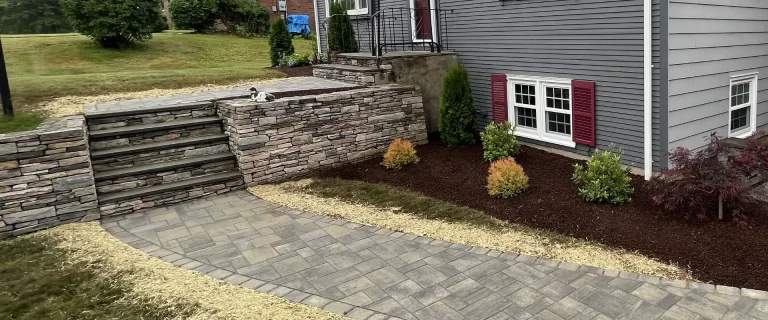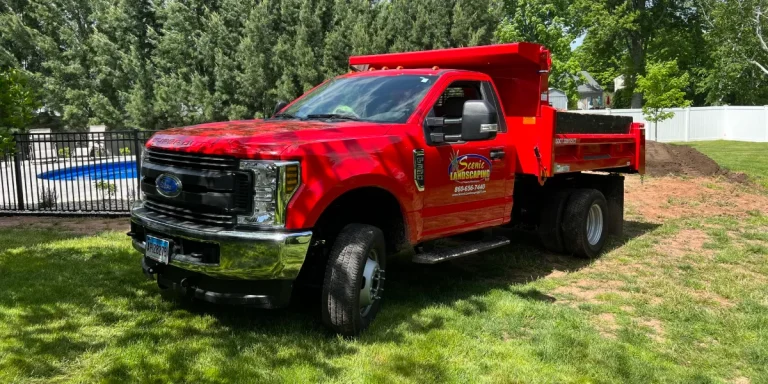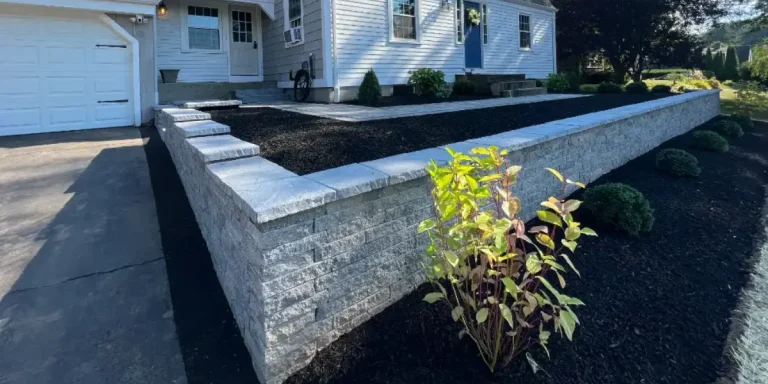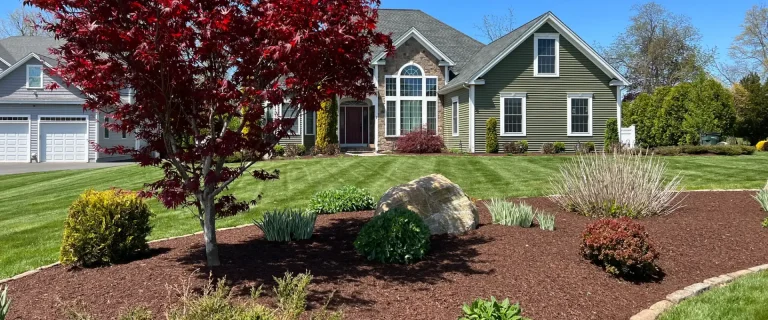How to Repair a Washed-Out Slope or Hill
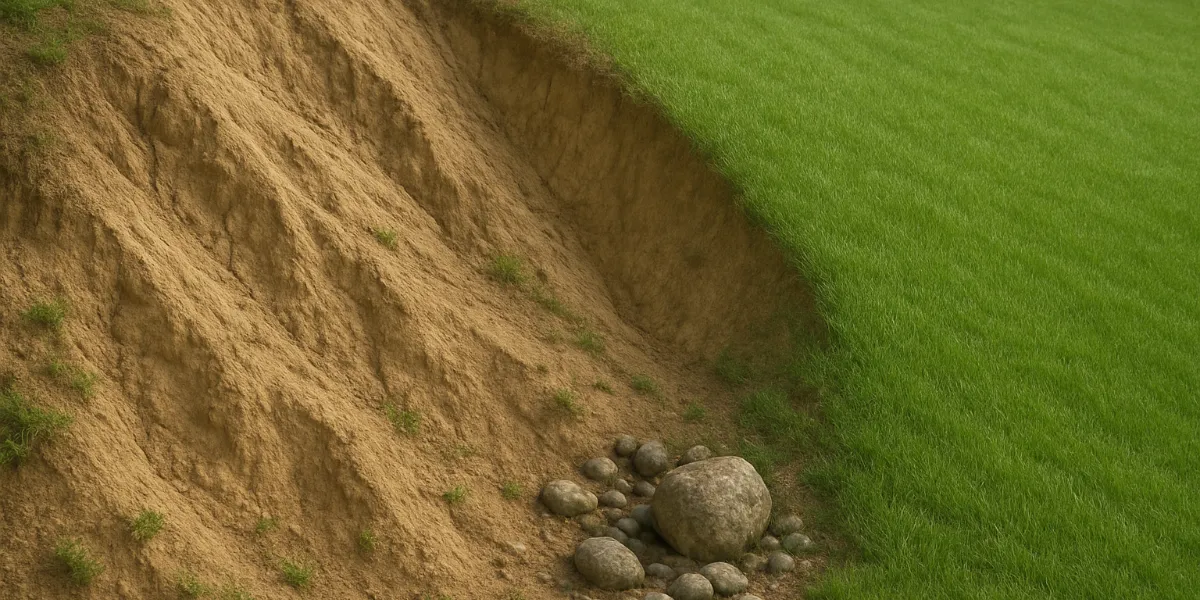
If your sloped yard is eroding every time it rains, you’re not alone. In hilly areas across Connecticut—including towns like Rocky Hill, Glastonbury, and Wethersfield—washed-out slopes are a common problem that can quickly go from an eyesore to a serious structural hazard. The good news? With proper assessment, the right techniques, and expert installation, these problem areas can be restored—and even turned into usable, attractive landscape features.
At Scenic Landscaping, we specialize in stabilizing and repairing erosion-prone slopes, using a combination of drainage solutions, grading, retaining walls, and planting techniques tailored to your unique property.
Why slopes wash out—and why it matters
Erosion occurs when water flows down a hill or incline and carries soil with it. Over time, this runoff wears away the slope, washing soil, mulch, or gravel into lower parts of your yard—or worse, toward your home’s foundation.
Common problems caused by slope erosion include:
-
- Loss of topsoil and exposed roots
- Gullying and surface washout
- Unstable ground around patios, driveways, or steps
- Drainage issues and foundation water damage
- Damage to nearby lawn or hardscape features
- Compromised aesthetics and curb appeal
Ignoring slope damage can lead to expensive repairs, including regrading or rebuilding large portions of your yard. That’s why early intervention is key.
Signs your slope needs repair
Erosion doesn’t always announce itself with dramatic damage. In many cases, the signs of a failing slope begin subtly and worsen over time. Recognizing early warning signals can help you prevent larger, costlier problems down the road.
If you’re noticing any of the following, it may be time to take action:
-
- Ruts, rivulets, or channels in the soil after rainfall
These small grooves are early indicators of water carving paths through your landscape. Left unaddressed, they can widen into deeper gullies. - Exposed tree or shrub roots
When the soil around plantings begins to erode, root systems are left vulnerable. This can compromise plant health and signal that topsoil is being steadily stripped away. - Displaced mulch, gravel, or decorative stone
If you find your mulch collecting at the bottom of a hill—or washing into walkways or patios—it’s a clear sign of surface runoff gaining speed on your slope. - Plants leaning downhill or growing unevenly
Slanted or uprooted plantings often reflect shifting soil or instability beneath the surface. These are subtle clues that the slope is under stress. - Soft spots, sinkholes, or sudden depressions
Unstable ground beneath the slope can cause sections to collapse or shift. These areas may feel spongy underfoot or appear as unexpected dips in your lawn. - Water pooling at the base of the hill or near your foundation
Accumulated water at the bottom of a slope can increase hydrostatic pressure on retaining walls or foundations, leading to structural concerns over time.
- Ruts, rivulets, or channels in the soil after rainfall
At Scenic Landscaping, we don’t just address visible symptoms—we diagnose the full picture. Our on-site assessments consider:
-
- Soil type and compaction
- Grading angles and runoff direction
- Existing plantings and root structures
- The presence or absence of drainage infrastructure
Once we identify what’s causing the erosion, we develop a solution that combines smart engineering with attractive, low-maintenance design. Whether that means regrading, installing retaining walls, or integrating a custom drainage system, we provide the right fix for your landscape’s unique challenges.
How we repair and stabilize a washed-out slope
Fixing an eroded hillside isn’t just about filling in the damage—it’s about preventing it from happening again. At Scenic Landscaping, we take a comprehensive approach that addresses the root causes of erosion while enhancing the overall usability and beauty of your landscape. Each solution is tailored to your slope’s soil type, angle, water flow, and surrounding features.
Here’s a deeper look at how we restore and reinforce washed-out hillsides:
1. Regrade the slope for stability
The first step in any successful slope repair is reshaping the land to manage how water moves through your property.
-
-
- We carefully contour the hillside to soften sharp angles and reduce the velocity of runoff.
- Soil is layered and compacted to ensure long-term support and resist future displacement.
- When appropriate, we design terraced retaining walls or stepped landings, turning a steep, unusable hill into flat, functional tiers for planting or seating.
-
Regrading also sets the foundation for any future enhancements, like sod installation, paver walkways, or outdoor living spaces.
2. Install drainage to control water flow
Erosion is water’s way of telling you that your yard isn’t draining properly. Without addressing runoff, even the best slope design won’t hold up.
We design and install effective drainage systems that move water safely away from erosion-prone areas:
-
-
- French drains target subsurface water and relieve soil pressure
- Drainage swales guide surface water in a controlled path along or across the hill
- Dry creek beds provide a decorative but functional solution for directing stormwater
- Catch basins and underground piping quickly collect and remove surface runoff
-
We often integrate these drainage elements with grading and hardscaping improvements to create a seamless, high-performing system.
3. Build retaining walls for structural support
In cases where the hill is too steep or unstable for natural reshaping alone, we construct retaining walls to provide both form and function.
-
-
- We use durable, aesthetically pleasing materials like Belgard stone block systems that blend beautifully with the landscape.
- Walls can be built in a single rise or in multiple tiers to create layers for garden beds, walkways, or lighting features.
- Every wall is engineered to handle Connecticut’s freeze-thaw cycles, heavy rains, and soil pressure—delivering long-term stability and visual impact.
-
These structures not only hold soil in place but can also double as seating, border edging, or the backbone for a larger landscape redesign.
4. Reinforce with erosion-control materials
Slopes are vulnerable in their early stages of restoration, which is why we stabilize the surface with erosion-resistant materials.
We apply:
-
-
- Geotextile fabrics to provide a barrier between soil and mulch or rock layers
- Erosion control blankets for steep grades, offering protection until vegetation takes hold
- Crushed stone or gravel in high-impact runoff areas to dissipate water flow
-
These layers help prevent fresh soil from washing away and allow newly installed vegetation to establish strong roots.
5. Add native plants and groundcover
Once the slope is reshaped and reinforced, vegetation plays a key role in long-term erosion control. The right plants anchor the soil naturally and improve water absorption.
-
-
- We recommend deep-rooted shrubs, ornamental grasses, and groundcovers known to thrive in sloped conditions
- Using native plants ensures low maintenance, drought resistance, and improved biodiversity
- These plantings are carefully positioned to support the slope’s structure while enhancing your property’s curb appeal
-
Our planting services are fully customized to each site’s sun exposure, soil condition, and desired level of maintenance—ensuring beauty and functionality throughout all four seasons.
Mini case study: A steep backyard in Glastonbury
A homeowner in Glastonbury came to us with a steep backyard that was losing soil after every rainfall. The mulch washed away, plantings kept failing, and water had begun pooling near the patio below. We designed a two-tiered solution:
-
- Regraded the slope to soften the incline
- Installed a retaining wall with integrated French drains
- Planted native ornamental grasses and shrubs to anchor the hillside
- Added a permeable paver patio to replace the eroded edge of the lawn
Within one season, the slope was stabilized, the runoff was under control, and the space had become both functional and beautiful.
Why choose Scenic Landscaping for slope repair?
Repairing a washed-out hill is about more than just moving dirt—it requires precision, creativity, and a solid understanding of how water, soil, and structure interact. At Scenic Landscaping, we bring years of experience to each project and offer:
-
- Complete grading and drainage solutions
- Custom-designed retaining walls and terraced landscapes
- Native, sustainable planting plans
- Certified NDS Drainage Contractor status
- A commitment to clean, professional installation and lasting results
From sloped side yards in Newington to hilly backyards in Berlin, we know how to turn challenging terrain into an asset.
We proudly serve homeowners and businesses in:
-
- Rocky Hill
- Glastonbury
- Wethersfield
- Newington
- Berlin
- Cromwell
- Middletown
- West Hartford
- Greater Hartford County and surrounding areas
Let’s rebuild your slope—and your peace of mind
If your hillside is eroding or your yard is washing away with every storm, it’s time to take action. Scenic Landscaping can help restore stability, improve drainage, and give your property a clean, finished look.
Call us at (860) 656-7440 or request a consultation online to get started. We’ll inspect the issue, design a solution, and deliver lasting results—built for Connecticut’s terrain and your lifestyle.

